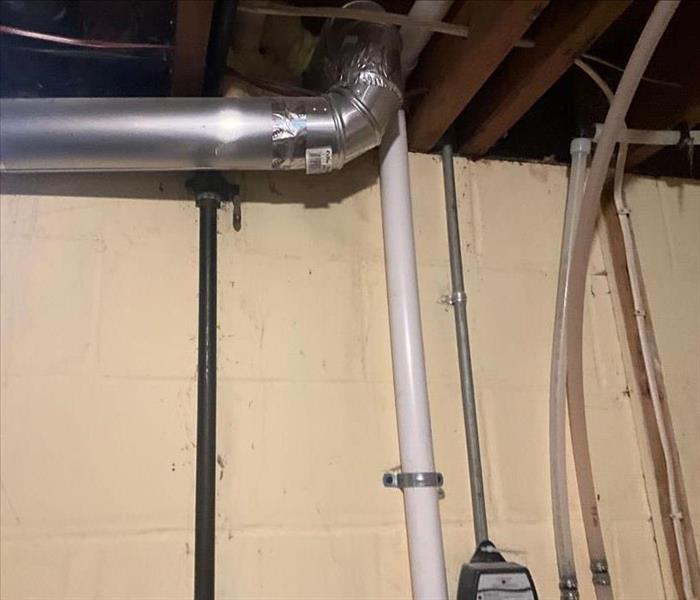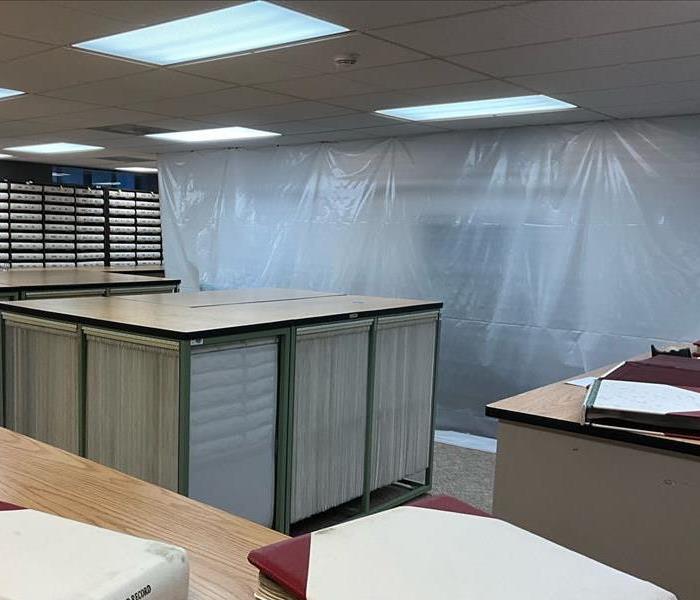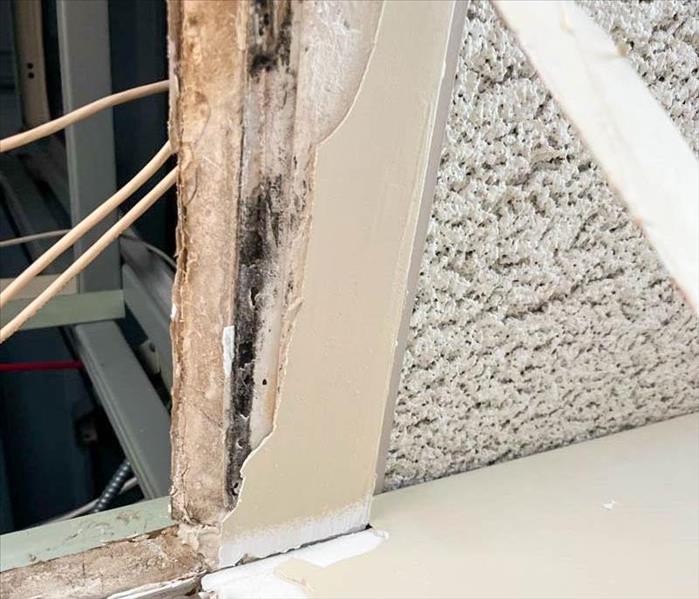Recent Mold Remediation Posts
Protect Your Home: Mold Prevention and the Unseen Water Threats
5/3/2024 (Permalink)
 The moisture-laden concrete provides an ideal breeding ground for mold, highlighting the importance of addressing water intrusion.
The moisture-laden concrete provides an ideal breeding ground for mold, highlighting the importance of addressing water intrusion.
Today, we're delving into a topic that often lurks unseen but can wreak havoc on your home: mold and the hidden water sources that fuel its growth. Mold is not only unsightly but can also pose health risks and cause significant damage to your property. By understanding the importance of mold prevention and being aware of the water you can't see, you can safeguard your home and your family's well-being.
The Hidden Water Threat: Water is essential for life, but when it infiltrates your home unseen, it can become a silent enemy. Leaky pipes, hidden plumbing issues, roof leaks, and poor ventilation can all contribute to excess moisture buildup within your home. Even minor water leaks, if left unchecked, can create the perfect environment for mold growth behind walls, under floors, and in other hidden areas.
Mold Thrives in Moisture: Mold spores are everywhere, both indoors and outdoors. They can enter your home through windows, doors, HVAC systems, and even on your clothing. However, mold requires moisture to grow and proliferate. When water sources go unnoticed or unaddressed, mold can quickly take hold and spread throughout your home.
The Dangers of Mold: Beyond its unsightly appearance and musty odor, mold can have serious consequences for your health and the structural integrity of your home. Exposure to mold can trigger allergic reactions, respiratory problems, and other health issues, particularly in individuals with asthma, allergies, or compromised immune systems. Additionally, mold can weaken building materials, leading to costly repairs and structural damage over time.
Mold Prevention Strategies: Preventing mold growth begins with controlling moisture levels in your home. Here are some essential strategies to help keep mold at bay:
Regular Inspections: Routinely inspect your home for signs of water damage, such as leaks, drips, and dampness. Pay close attention to areas prone to moisture buildup, such as basements, crawl spaces, bathrooms, and kitchens.
Prompt Repairs: Address any water leaks or plumbing issues promptly to prevent moisture from accumulating. Repair roof leaks, seal cracks in the foundation, and ensure proper drainage around your home to divert water away from the foundation.
Proper Ventilation: Use exhaust fans in bathrooms and kitchens to remove excess moisture generated from cooking, showering, and bathing. Ensure that your HVAC system is properly maintained, including regular filter changes and inspections for mold growth in ductwork.
Monitor Indoor Humidity: Keep indoor humidity levels between 30% and 50% to discourage mold growth. Use a dehumidifier in damp areas if necessary, particularly during humid summer months.
Professional Inspection and Remediation: If you suspect mold growth in your home or if you've experienced water damage, don't hesitate to contact professionals like SERVPRO of Northeast Minneapolis for a thorough inspection and remediation services. They have the expertise and equipment to identify hidden water sources, assess mold damage, and safely remove mold from your home.
Don't let unseen water threats lead to mold growth and damage in your home. By staying vigilant, addressing water issues promptly, and implementing mold prevention strategies, you can protect your home and your family from the harmful effects of mold. Remember, when it comes to mold prevention, an ounce of prevention is worth a pound of cure. If you need assistance with mold inspection or remediation, SERVPRO of Northeast Minneapolis is here to help!
Behind the Scenes: A Day in the Life of a Mold Remediation Professional
3/13/2024 (Permalink)
 By establishing barriers, we prevent mold spores from spreading to unaffected areas.
By establishing barriers, we prevent mold spores from spreading to unaffected areas.
Curious about what happens behind the scenes when you're not looking? Take a peek into a typical day in the life of a mold remediation pro. Picture it as a sneak peek into the world of those on a mission to kick mold to the curb, keeping your home a mold-free zone. No capes or high-tech gear, just a casual day in the life of the folks committed to winning the battle against mold.
Preparation: Equipping for the Task at Hand
Before engaging in mold remediation, a critical step involves the preparation. Our team ensures the proper wear of protective gear, including coveralls, gloves, and respirators, prioritizing safety as we enter affected areas.
Assessment: Unveiling the Extent of the Challenge
Our initial focus revolves around a comprehensive inspection. Armed with sharp observational skills, we meticulously evaluate affected areas, identifying visible mold and potential sources of moisture contributing to its growth.
Containment: Restricting the Spread of Mold
Once the assessment is complete, our strategy shifts to containment. By establishing barriers, we prevent mold spores from spreading to unaffected areas, creating a controlled environment conducive to effective remediation.
Remediation: Methodical Elimination of Mold
With containment protocols in place, our removal process begins. Armed with safe, effective cleaning agents, our team diligently eliminates mold from surfaces. Stubborn mold may necessitate advanced methods to ensure thorough removal.
Ventilation and Drying: Restoration of Environmental Balance
The next step involves ventilation and drying. Picture this – ventilation swoops in, like a pro, purging the air of any lingering mold spores. Meanwhile, our advanced drying gear tackles the core issue, addressing the source of moisture that mold thrives on. This process ensures we not only clear out airborne mold but also eliminate the conditions that invite it in.
Post-Remediation Inspection: Confirming Success
Lastly, a meticulous post-remediation inspection follows, leaving no nook or cranny uninspected. Our expertise is applied to verify the success of our efforts, ensuring a mold-free environment for homeowners.
In essence, this encapsulates a day in the life of a mold remediation professional. No theatrical capes or superhero motifs—just a dedicated team armed with knowledge, protective gear, and an unwavering commitment to restoring homes to a mold-free state. If you need mold remediation services, don’t hesitate and give our SERVPRO of Northeast Minneapolis team a call today!
How Mold and Fire Damage Restoration Interconnect
11/20/2023 (Permalink)
 Prevention is always better than restoration.
Prevention is always better than restoration.
In today's blog, we will explore an important topic that may be unfamiliar to many: the interconnection between mold and fire damage restoration. Understanding this connection is crucial for homeowners and property managers to effectively address both issues and ensure the complete restoration of their properties. So, let's dive into how mold and fire damage restoration go hand in hand.
1. Mold Growth as a Result of Fire Damage
When a property experiences a fire, the aftermath brings a host of challenges, including water damage from firefighting efforts. Moisture, combined with the remaining heat and organic materials, creates a favorable environment for mold growth. We'll discuss how fire damage can lead to mold development and provide guidance on detecting and addressing mold growth during the restoration process.
2. Restoring a Fire-Damaged Property to Prevent Mold Infestation
Efficient and thorough fire damage restoration is the crucial first step in preventing mold infestation. The process involves several key steps, including:
- Cleanup: Removing debris, charred materials, and residues is essential to eliminate the environment that fosters mold growth.
- Water Extraction and Drying: Residual water from firefighting efforts needs to be promptly extracted, followed by thorough drying to prevent lingering moisture that would contribute to mold growth.
- Structural Assessment: Evaluating the structural integrity of the property is crucial, ensuring any compromised areas or materials are identified and addressed.
- Odor Removal: Lingering smoke and odors can indicate hidden damage and should be thoroughly addressed to prevent further issues.
3. Addressing Mold Contamination During Fire Damage Restoration
If mold is discovered during the fire damage restoration process, specialized techniques are required to handle the situation effectively. We'll delve into the strategies and protocols utilized by SERVPRO® professionals to identify, contain, and remediate mold contamination while concurrently restoring fire-damaged areas. By understanding how mold removal intertwines with fire damage restoration, readers will be better equipped to tackle both challenges simultaneously.
4. Preventative Measures for Mold and Fire Damage Restoration
Prevention is always better than restoration. We'll provide practical tips and best practices for homeowners to minimize the risk of mold growth and fire incidents in their properties. From regular inspections to proper ventilation and early detection devices, our advice will assist readers in safeguarding their homes against potential mold and fire damage.
As a Minneapolis resident, being aware of the connection between mold and fire damage restoration is paramount for effectively addressing these issues. By understanding this interconnection, homeowners and property managers can navigate the restoration process efficiently, ensuring comprehensive restoration while minimizing the risk of mold infestation. At SERVPRO® of Northeast Minneapolis, we're committed to providing the knowledge and expert services necessary to assist property owners in their restoration journey. If you require professional assistance, please don't hesitate to contact us. Stay proactive, stay safe!
Why Does Mold Grow in My House?
5/16/2023 (Permalink)
Mold is a common problem that many homeowners face. It can cause damage to your home and belongings, as well as create an unpleasant musty smell. But why does mold grow in the first place? In this blog, we’ll explore the reasons why mold grows in houses and what you can do to prevent it.
Moisture
One of the main reasons why mold grows in houses is due to moisture. Mold spores are present in the air all around us, but they need a moist environment to grow. If your home has areas that are consistently damp or wet, then mold is likely to grow there.
Common sources of moisture in homes include:
- Leaky pipes or appliances
- High humidity levels
- Water damage from flooding or heavy rain
- Poor ventilation in bathrooms, kitchens, and laundry rooms
Poor Ventilation
Another reason why mold may grow in your home is poor ventilation. When moisture is trapped in a room, it can lead to the growth of mold. This is particularly true in areas such as bathrooms and kitchens, where moisture levels are naturally higher.
To prevent mold growth due to poor ventilation, make sure that your home is properly ventilated. This means installing exhaust fans in areas where moisture is likely to accumulate, such as the bathroom, kitchen, and laundry room.
Poor Insulation
Poor insulation can also contribute to the growth of mold in your home. When warm, moist air comes into contact with cold surfaces, condensation can occur. This can lead to the growth of mold in areas such as attics, basements, and crawl spaces.
To prevent mold growth due to poor insulation, make sure that your home is properly insulated. This includes insulating your attic, walls, and crawl spaces.
Clutter
Clutter in your home can also contribute to the growth of mold. When items are stored in damp or humid areas, such as basements or closets, mold can grow on them. This can be particularly problematic if the items are made of organic materials, such as paper or fabric.
To prevent mold growth due to clutter, make sure that your home is organized and that items are stored in dry, well-ventilated areas. Avoid storing items in basements or crawl spaces unless they are properly sealed and protected from moisture.
In conclusion, mold growth in your home is often due to a combination of factors, including moisture, poor ventilation, poor insulation, and clutter. By addressing these issues, you can help prevent mold growth in your home. Make sure that any leaks or water damage are promptly addressed, and that your home is properly ventilated and insulated. Keep your home organized and avoid storing items in damp or humid areas. By taking these steps, you can help ensure that your home remains mold-free.
 The moisture-laden concrete provides an ideal breeding ground for mold, highlighting the importance of addressing water intrusion.
The moisture-laden concrete provides an ideal breeding ground for mold, highlighting the importance of addressing water intrusion.





 24/7 Emergency Service
24/7 Emergency Service

